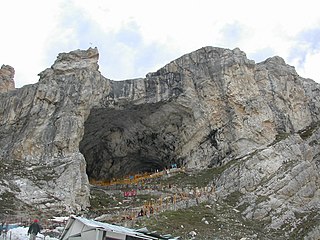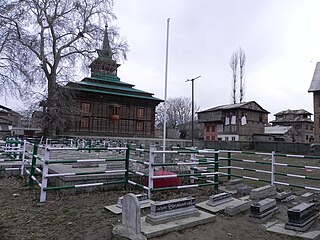The following lists events that happened during 1987 in South Africa.

The insurgency in Jammu and Kashmir, also known as the Kashmir insurgency, is an ongoing separatist militant insurgency against the Indian administration in Jammu and Kashmir, a territory constituting the southwestern portion of the larger geographical region of Kashmir, which has been the subject of a territorial dispute between India and Pakistan since 1947.

Terrorism in India, according to the Home Ministry, poses a significant threat to the people of India. Compared to other countries, India faces a wide range of terror groups. Terrorism found in India includes Islamic terrorism, ultranationalist terrorism, and left-wing terrorism. India is one of the countries most impacted by terrorism.

Amarnath Temple is a Hindu shrine located in the Pahalgam tehsil of the Anantnag district of Jammu and Kashmir, India. It is a cave situated at an altitude of 3,888 m (12,756 ft), about 168 km from Anantnag city, the district headquarters, 141 km (88 mi) from Srinagar, the summer capital of Jammu and Kashmir, reached through either Sonamarg or Pahalgam. It is an important shrine in Hinduism.

India–Pakistan relations are the bilateral ties between the Republic of India and the Islamic Republic of Pakistan. The two countries have a complex and largely hostile relationship that is rooted in a multitude of historical and political events, most notably the partition of British India in August 1947.
Statements in response to the 11 July 2006 Mumbai train bombings came from heads of state, political leaders, and militant leaders from around the world. Most offered some sort of condemnation of the attacks and commented on terrorism as a whole.

Al-Badr is an Islamist militant group operating in the Kashmir region. The group was allegedly formed by the Pakistani Inter-Services Intelligence (ISI) in June 1998. It is believed the group was encouraged by the ISI to operate independently from their previous umbrella group, Hizb-ul-Mujahideen (HM). Prior to the group's separation from HM, they participated in the fighting in Afghanistan in 1990 as part of Gulbuddin Hekmatyar's Hizb-l-Islami (HIG) alongside other anti-Soviet Afghan mujihadeen. India and the United States have declared it a terrorist organisation and banned it. Pakistan has long been a difficult and disruptive neighbor of Afghanistan, increasing Afghanistan's instability by providing intelligence, weapons and security to the Afghan Taliban and the Haqqani network. But now Pakistan is facing strong backlash both domestically and internationally against its policy of militant sponsorship.
On Monday, 1 October 2001, three militants belonging to Jaish-e-Mohammed carried out an attack on the Jammu and Kashmir State Legislative Assembly complex in Srinagar using a Tata Sumo loaded with explosives, ramming it into the main gate with three fidayeen suicide bombers. 38 people, plus the three attackers, were killed.

The Sindhudesh Liberation Army is a Sindhi Militant organization based in the Sindh province of Pakistan. It became publicly known in 2010 after it claimed responsibility for a targeted bomb blast on railway tracks near Hyderabad, Pakistan. The group is currently active.
An attack on a Central Reserve Police Force camp at Bemina, Srinagar, Jammu and Kashmir, India, occurred on 13 March 2013. It resulted in the death of five CRPF personnel and two attackers. Ten others were also injured include security personnels and civilians.

KashmirMartyrs' Day or Kashmir Day, was a former official state holiday observed in Kashmir in remembrance of 21 Muslim protesters killed on 13 July 1931 by Dogra forces of the princely state of Jammu and Kashmir in British India.
On 5 December 2014, there were four different terror attacks at multiple places in the Kashmir Valley of the state of Jammu and Kashmir in India.
The 2016 Pampore attack was a attack by militants of the Jihadist group, Lashkar-e-Taiba on 25 June 2016, near Frestabal area of Pampore on Srinagar-Jammu National Highway in Jammu and Kashmir.

The 2016–2017 unrest in Kashmir, also known as the Burhan aftermath, refers to protests in the Indian state of Jammu and Kashmir, chiefly in the Kashmir Valley. It started after the killing of militan leader Burhan Wani by Indian security forces on 8 July 2016. Wani was a commander of the Kashmir-based Islamist militant organisation Hizbul Mujahideen.

The Insurgency in Sindh is a low-intensity insurgency waged by Sindhi Nationalists against the government of Pakistan. Sindhi nationalists want to create an independent state called Sindhudesh. However, this movement never gained support from the populace of urban Sindh.
On 30 July and 6 August 2002, in the month of Shraavana, 11 people were killed and 30 injured in a terror attack by Islamic extremists from Lashkar-e-Taiba's front group of al-Mansuriyan, on Nunwan base camp at Pahalgam of the Amarnath Hindu pilgrimage (Yatra) to Amarnath Temple glacial cave shrine in Kashmir Valley in the Indian state of Jammu and Kashmir. In the spate of attacks on Yatra in the third consecutive year, 2 pilgrims were killed and 3 injured on 30 July when terrorists threw grenades at a civilian taxi of pilgrims in Srinagar. Further, 9 people were killed and 27 injured on 6 August by Lashkar-e-Taiba (LeT) terrorists' hail of bullets at Nunwan base camp at Pahalgam.

Indian Army operations in Jammu and Kashmir include security operations such as Operation Rakshak, which began in 1990, Operation Sarp Vinash in 2003 and Operation Randori Behak in 2020. Other operations include humanitarian missions such as Operation Megh Rahat and operations with a social aim such as Operation Goodwill and Operation Calm Down. The Indian Army works in tandem with the other arms of the Indian Armed Forces and security forces in Jammu and Kashmir such as during Mission Sahayata or joint operations.

Crowd control in Jammu and Kashmir is a public security practice to prevent and manage violent riots. It is enforced by police forces through laws preventing unlawful assembly, as well as using riot control agents such as tear gas, chili grenades, and pellet guns.
On 6 March 2022, a militant threw a grenade at a marketplace in Srinagar, Indian-administered Jammu and Kashmir, injuring twenty-four people and killing two.











